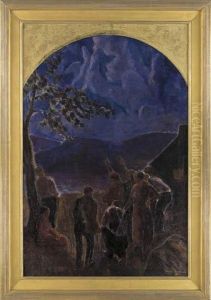Malvin Gray Johnson Paintings
Malvin Gray Johnson was an influential African American painter born in Greensboro, North Carolina, on January 28, 1896. His brief life, ending at the age of 38 on May 1, 1934, was marked by significant contributions to the Harlem Renaissance, a cultural, social, and artistic explosion that took place in Harlem, New York, during the 1920s and early 1930s. Johnson's work is celebrated for its vibrant portrayal of African American life and its innovative approach to color and form.
Johnson's interest in art began at a young age, and he moved to New York City as a teenager to pursue his artistic ambitions. He studied at the National Academy of Design and worked under the guidance of Charles Webster Hawthorne. Johnson's early work was heavily influenced by the academic style of his education, but he soon began to explore and incorporate African motifs and jazz rhythms into his paintings, reflecting the broader explorations of African American identity within the Harlem Renaissance.
Throughout his career, Johnson experimented with various styles, including Impressionism, Cubism, and Expressionism. His work is characterized by a dynamic use of color and a strong sense of geometric composition, often blending traditional African art forms with modernist aesthetics. One of his most famous works, 'Swing Low, Sweet Chariot,' exemplifies his ability to merge these influences into a cohesive and powerful commentary on the African American experience.
Despite his early death, Johnson left behind a significant legacy. His art was featured in several landmark exhibitions of African American art, both during his lifetime and posthumously. Today, Malvin Gray Johnson's paintings are recognized as important contributions to American art, offering insights into the complexities of racial identity and the creative energy of the Harlem Renaissance. His work is held in the collections of major museums and continues to inspire new generations of artists and art lovers alike.
